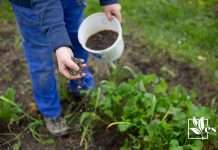Watering practices are essential to the health of any plant, and boxwoods, with their dense foliage and elegant form, require particular attention to ensure they thrive in the garden. After planting a boxwood, regular watering helps the plant to establish a strong root system. The frequency of watering is determined by factors such as soil type, climate, and the age of the plant.

As a general rule, young boxwoods require consistent moisture to foster growth, whereas established boxwoods have more drought tolerance. I check my plants by feeling the soil approximately 2 to 4 inches below the surface; if it’s dry, I water them.
I have observed that well-draining sandy loam suits boxwoods best, as it provides the right balance of moisture retention and drainage. My aim is to provide them with a hearty drink when the top few inches of soil dry out. Based on my experience, a boxwood’s watering needs also tie in with exposure to sunlight, with ideally 6 hours of direct sun fostering optimum foliage.
In my garden, I ensure my boxwoods do not sit in waterlogged soil to prevent root rot and other diseases. A moderate climate typically means a less rigorous watering schedule, and attention to specific weather conditions and seasonal variations can reduce the risk of overwatering. Weather and rainfall patterns naturally influence how often I water my boxwoods to maintain their beauty and health.
JUMP TO TOPIC
Cultivating Boxwoods in Your Garden
Growing boxwoods successfully requires understanding their specific needs for soil, light conditions, and careful initial planting. I’ll guide you through creating the right environment for these versatile shrubs.
Selecting the Right Soil and Climate Conditions
Boxwoods thrive in a variety of climates, but they do have preferences in temperature and soil conditions. They can tolerate temperatures well below freezing, but for optimal growth, the climate should not regularly dip below -20°F.
Drainage: Well-drained soil is critical to prevent root rot. If your natural soil is not well-draining, consider amending it with organic materials or planting boxwoods in raised beds.
pH Levels: Boxwoods prefer soil that is slightly acidic to slightly alkaline (pH 6.5 to 7.5). Regularly test your soil’s pH and adjust as needed.
Adequate drainage is a must, to avoid waterlogged roots, so consider amending the soil with organic material if necessary. A good layer of organic mulch can help the soil retain moisture, keep the roots cool, and suppress weeds.
Planting and Initial Care
When planting boxwoods, I make sure to dig a hole that is as deep as the root ball and twice as wide. This gives the roots plenty of room to expand and access the water they need without becoming too wet.
After placing the boxwood, I backfill the hole with the excavated soil and water thoroughly. This initial watering settles the soil around the roots and helps eliminate any air pockets.
To maintain optimal moisture levels for new plantings, provide 1 inch of water per week. Established boxwoods, however, need minimal watering unless there’s a prolonged drought. A soaker hose or drip irrigation is a wise investment to regulate the water supply efficiently and to avoid overwatering.
As the boxwoods grow, monitor the soil moisture regularly: it should be moist, not soggy. Proper planting and initial care set the foundation for a healthy boxwood that will enhance your garden for years to come.
Maintaining Healthy Boxwoods
In my experience with boxwoods, ensuring healthy growth hinges on proper watering, mulching, fertilizing, and pruning methods.
Watering and Mulching Techniques
I’ve learned that boxwoods thrive when watered appropriately, which means considering both the plant’s needs and environmental factors. Firstly, I establish a consistent watering routine to maintain soil moisture without causing waterlogging. Here’s how I do it:
I give my boxwoods a deep drink of water, slowly and deeply, to reach the entire root system, especially before the ground freezes in late autumn or early winter.
I avoid daily light sprinklings, as this can lead to shallow roots. Instead, I opt for a soaker hose or a drip system, which I find provides the optimal amount of water at a rate that the soil can absorb. I make sure to adjust my watering frequency according to rainfall, to prevent overwatering. Alongside watering, mulching is critical:
- Apply a 1-inch layer of mulch like pine bark, avoiding hardwood that can compact.
- The mulch helps regulate moisture and drainage, maintaining even soil temperature.
Fertilizer and Pruning Practices
Fertilizing and pruning are essential steps in the care of boxwoods that go hand in hand with watering and mulching.
Fertilizing: I apply an all-purpose fertilizer to nourish my boxwoods, following the manufacturer’s directions, usually in early spring. This supports lush foliage and a robust root system.
When it comes to pruning:
- I prune my boxwoods to maintain shape and promote healthy growth, doing most of the pruning in late winter to early spring.
- I always use sharp tools to make clean cuts, which helps prevent disease and promotes faster healing.
Regular maintenance, including checking for and addressing any signs of pests or disease, is necessary to keep boxwoods healthy. By combining these practices, I’ve been able to foster boxwoods that not only survive but thrive year after year.
Protecting Boxwoods from Common Problems
To ensure the health and beauty of boxwoods, it’s crucial for me to address both biotic and abiotic factors that can cause harm. Pests and diseases pose a significant threat, as do various environmental stressors. By implementing specific strategies, I can safeguard these shrubs effectively.
Pests and Diseases
Leafminers, psyllids, and mites are among the most prevalent pests that can damage boxwood foliage, leading to yellow leaves and overall decline.
I often check my boxwoods for signs of leafminers, which burrow into the leaves, leaving visible trails. Psyllids also cause harm by inducing cupping of the leaves. To combat these pests, I rely on a combination of biological control and, when necessary, the application of insecticides.
Vigilance against diseases like root rot is crucial, which is why I ensure proper drainage and avoid overwatering.
Environmental Stressors
Proper mulching has multipurpose benefits for boxwoods. Not only does it conserve soil moisture, but it also helps regulate soil temperature, protecting the roots, especially during winter.
💥 Environmental Factors
Shrubs planted in unsuitable conditions are prone to stress, leading to diminished health and increased vulnerability to pests and diseases. That’s why I take extra care to select species and cultivars that are well-suited to my local climate and meticulously tailor care to their needs.
Landscape Design Using Boxwoods
In my experience, the key to effective landscape design with boxwoods is utilizing their versatile nature and evergreen foliage to create structures and choosing the right varieties to suit various garden settings.
Creating Shapes and Structures
Boxwoods are a staple in formal gardens for their ability to be shaped into crisp hedges or elegant topiaries. I’ve found that they are particularly useful for creating defined spaces within a garden due to their dense, evergreen foliage. They bring a sense of organization to the landscape, serving as living walls or borders. For example, a hedge of Buxus sempervirens, also known as common or English boxwood, can provide privacy or frame a view, with its ability to reach a considerable mature height if left untrimmed.
To keep boxwoods healthy and maintain a specific shape, regular pruning is necessary. I prefer to prune in late spring, after the risk of frost has passed, which allows the plant to heal without new growth being damaged by cold.
Choosing Varieties for Different Settings
When selecting boxwoods for a landscape, considering the site’s exposure to sun and shade is critical. I recommend varietals like Buxus microphylla, or Japanese box, which can tolerate full sun to partial shade. They are a sound choice for many gardens due to their slow-growing nature and adaptability.
The site’s soil is also essential for boxwood health. In my landscape designs, I ensure that my boxwood planting areas have well-drained, loamy soil to prevent root rot, considering their shallow root systems. Here’s a simple rundown of boxwood care in terms of exposure and soil preference:
| Variety | Sun Exposure | Soil Preference |
|---|---|---|
| Common Boxwood (Buxus sempervirens) | Partial Shade to Full Sun | Loamy, Well-Drained |
| Japanese Box (Buxus microphylla) | Full Sun to Partial Shade | Loamy, Well-Drained |












